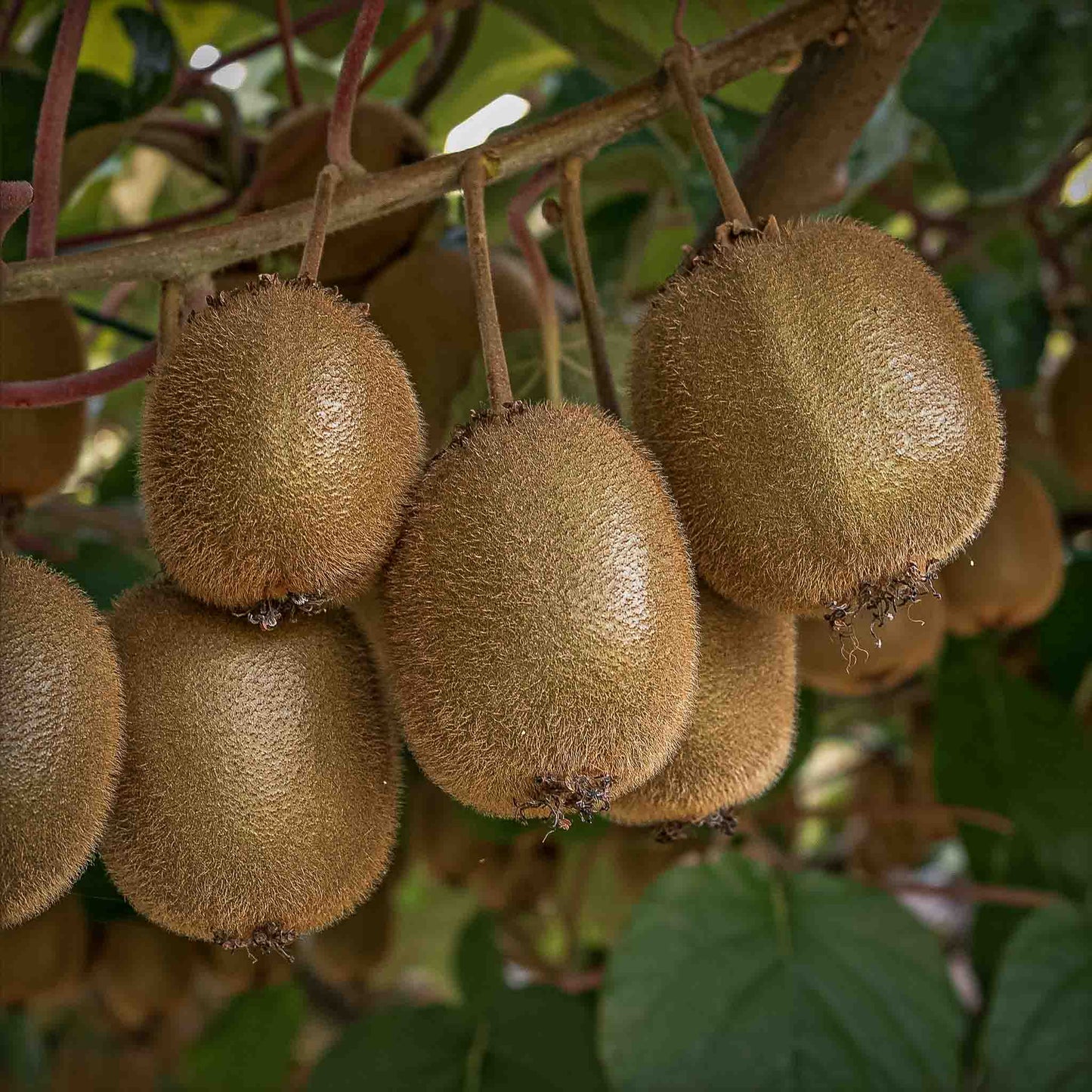Fruits And Shoots Plant Farm LTD.
Kiwi | Saanichton
Kiwi | Saanichton
Pick Up March 1, 2025
Couldn't load pickup availability
Saanichton fuzzy kiwi is a variety well suited for the backyard grower. The fruit is extra-large and egg-shaped and this kiwi is actually the variety you will typically find in the supermarket. Saanichton bears fruit in its 3rd year but requires a male pollination partner (We highly recommend Matua.) Note that a single male can pollinate up to 7 female plants but is itself non bearing. With their dramatic tropical-looking foliage, Saanichton kiwis make an attractive and vigorous climber and should be given a large fence or trellis to support its size. At maturity it will reach a spread of 8 to 10 ft; to maintain a smaller plant, summer pruning is recommended. In early spring they bear large, single white flowers followed by the russet coloured fuzzy brown fruit in late October. Saanichton has proven itself a heavy producer (100+ Ibs) so expect an abundance of these sweet, tropical fruits. It was developed in Canada and is hardy to zone 7-9 so a great choice for West Coast gardeners.

More plants in-store.
Email or call us at 604-997-3563 if you can't find what you are looking for and we will be glad to assist you!
Care & Handling
How do I care for my bare root fruit tree?
We recommend that you plant your bare root fruit tree as soon as you can after picking them up, and if that is not possible, cover the bare roots with bark mulch, sawdust, or even garden soil until you have time to plant them in their forever homes.
What is the best location for fruit trees?
Most fruit trees are not too fussy about the type of soil they are grown in but they will not perform well in heavy and wet soils. If you have drainage issues, add drainage or choose a different location. Fruit trees and shrubs do well in a fungally dominant soil. This can be obtained by mulching heavily with wood chip mulches and adding wood chip compost around the tree at time of planting. Heavy clay soils can be amended with the addition of wood chip mulches or wood chip compost.
Fruit trees should be planted where they get full sun exposure. Apples and pears can tolerate some shade, but stone fruits like cherries, plums and nectarines prefer full sun exposure and should be getting a minimum of 6 hours of sunshine per day). In the cool maritime climate of the Fraser Valley, nectarines, peaches and apricots must be grown under the eaves of your home facing South or West to prevent fungal problems such as peach leaf curl.
Planning an orchard?
Fruit trees are relatively permanent and it is important to select a spot that will not be problematic in the future. Here are some tips for laying out your space for long term success.
Account for the growth and maturity of your tree. Though fruit trees respond very well to training and pruning, it is important to allow for their growth. Many of our trees are on dwarf rootstock to limit the size and spread of the tree.
If you have a small space garden or desire a large selection of fruit trees, we suggest using cordons or espaliers. Espaliered apple trees can be spaced 8-10 feet apart on a fence or framework and only take up a foot or so in width. This form is excellent for long pathways or fencelines. The height of the espalier can be set at one tier a foot off the ground, to as many as 5 or 6. Cordons are highly trained trees maintained to a narrow column.
How do I plant a fruit tree?
If your tree is rooted in a pot, you can skip the first step. Take your young bare root tree and begin by removing any dead or damaged roots or branches with a sharp pair of pruners. At this stage we also begin the initial pruning and shaping of the young tree.
We always immerse the transplants in a bucket of water for several hours to rehydrate the plants.
Dig a hole about a foot in diameter and mix in some well aged wood chip based compost with the soil. If composted wood chips are not available use fresh wood chips from hardwood or softwood trees avoiding cedar or walnut. The woody material retains moisture around the root zone and will release nutrients to your young tree as it grows.
For bare root trees, spread out the roots in all directions and refill the hole with the original soil and wood mulch. If your tree is rooted in a pot, ruffle the roots and break them up to encourage them to begin moving out of the pot’s shape.
We recommend watering in with a mycorrhizal fungi inoculant to establish the best health for your new plant. Mycorrhizal fungi form a powerful symbiotic relationship with the plant protecting it from disease and drought while releasing essential nutrients to the root zone of the plant. The plant in exchange provides carbohydrates to the fungi. For the organic grower this is the best way to promote plant health without any additional fertilizer inputs needed.
In the first year, water deeply once every 10 days through the dry months of summer.
Should I stake my new fruit tree?
Freshly planted trees should be staked for the first year. Dwarf fruit trees are grafted on relatively weak root stock and need to be staked to hold the tree up throughout the life of the tree . Place a post on the East and West sides of the tree about a foot away from the trunk. The posts serve two purposes, they support the tree when weighted down with fruit and they can be used to tie down young branches to shape the tree. Use soft materials as opposed to wire when tying the trees to the post to prevent the wire from getting embedded into the stems.
How much care do fruit trees require?
For the organic backyard grower the main task in caring for fruit trees is in the shaping and pruning. We like to maintain our fruit trees to a manageable height and spread which involves pruning two or three times a year. The amount of labour entailed depends on the tree but anticipate spending a total of 2 hours of work per tree every year, more for larger fruit trees, and less if the tree is dwarf.
During our first yearly pruning at the beginning of June we also thin down the fruit on our trees to promote heavy and large fruit to develop and prevent branches from being overloaded and possibly breaking. Thinning is hard for many home growers but the remaining fruit will be better because of your diligence.
The only other maintenance required is to pick and process or store the fruit you have grown, but that doesn’t feel like work!
How often should I fertilize my fruit trees?
In the wild nobody is going about fertilizing trees, and yet the health of wild trees seems to surpass the health of many yards where chemical fertilizers are applied. We never use chemical fertilizers on any of the plants we grow unless they are in pots. Research has shown that the mycorrhizal fungi on the roots of the tree will provide the nutrients that the plant needs when it needs it throughout the life of the tree!. In fact, adding chemical fertilizers to a plant that has mycorrhizal fungi growing on it can have a negative impact on the relationship and even kill the fungi.
Mycorrhizal fungi form a powerful symbiotic relationship with the plant protecting it from disease and drought while releasing essential nutrients to the root zone of the plant. The plant in exchange provides carbohydrates to the fungi. For the organic grower this is the best way to promote plant health without any additional fertilizer inputs needed.
We sell “root rescue”containing many different strains of mycorrhizal fungi to help establish this natural relationship between your trees and the soil.
Should I mulch my fruit trees?
Trees do best in a soil that is dominated by fungi. Fungi grow well on woody material like wood chips or compost that is high in woody material. We recommend applying a yearly mulch of 2-3 inches of wood chips around the base of your fruit trees. In addition to this we recommend planting perennial plants or low growing shrubs to protect the soil life around your tree and promote predatory ground beetles which in turn will help control pests like codling moths that overwinter on the ground.
What is a dwarf fruit tree?
When you buy a Honeycrisp apple from the store, you are buying a fruit that you know and love and your expectations are that it will be sweet, crispy and juicy. All of those honeycrisp apples in all the stores are genetic clones that came from one parent plant (a seedling developed at the university of Minnesota). That one plant has been propagated thousands of times to produce the millions of pounds of fruit people consume each year.
To produce a new plant a young piece of the mother plant gets grafted onto a rootstock. It is the different rootstocks that control the growth of the plant through its life. Each rootstock imparts different properties to the plant that is growing on it but the main thing we look at is how dwarfing the rootstock is.
Mini-dwarfing root stock in apples for example can produce a plant that is 1/5 the size of a standard plant. This is great for small space gardens or containers but will not be suitable for an orchard where the tree is meant to fend for itself.
Dwarf root stock produces a plant that is 1/4 the size of the parent plant. These trees are great for espaliering and small spaces.
Semi dwarf apple trees have root stock that allow the plant to grow 3/5 the size of the parent plant while standard rootstock will produce an old fashioned tree with large proportions such as you may remember from your childhood. Semi standard and standard size trees do not require staking beyond the first year or two.
If the Honeycrisp apple was grafted on each of the rootstocks mentioned above, the fruit would be the same on each of them. They would taste and look the same. The only difference would be the size of the tree and the amount of fruit produced per tree.

